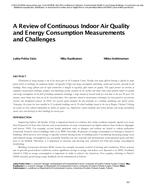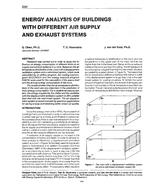Computer models for predicting the steady-state and seasonal performance of electric driven, air-source heat pumps are described. Laboratory data on the heating and cooling performance of two heat pumps (under steady-state conditions) are compared with model predictions. Measurements of the seasonal and annual energ consumption for an electric heat pump installed in an unoccupied home in Knoxville, TN, are presented and also compared with model predictions.
A method for combining the steady-state and seasonal performance calculations and placing them under the control of a numerical optimization procedure is described. This combined code was used to determine the design of a heat pump which minimized annual energy consumption and yet met a design cooling capacity and had fan and compressor efficiencies and total heat exchange surface area comparable to one of the heat pumps used for the laboratory tests. The optimization results indicated a 16% reduction in annual energy consumptions but it was determined that about half of the energy savings was due to assumptions or the steady-state calculations. The true energy savings were found to result from reduced fan powers and lower cycling losses. Similar analyses were performed for a central air-conditioner and a heat pump with idealized refrigerant flow control.
Units: Dual
Citation: Symposium, ASHRAE Transactions, 1985, vol. 91, pt. 2B, Honolulu, HI
Product Details
- Published:
- 1985
- Number of Pages:
- 15
- File Size:
- 1 file , 3 MB
- Product Code(s):
- D-HI-85-10-1


